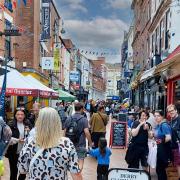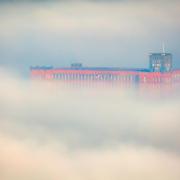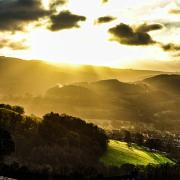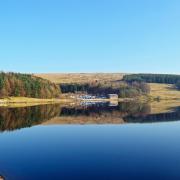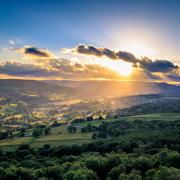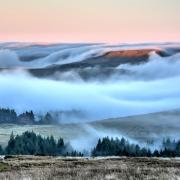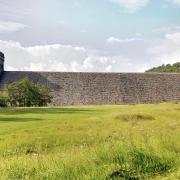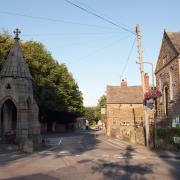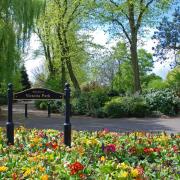Derbyshire and the wider Peak District is a treasure trove of wonderful places to visit and stay a while.
Travel around the stunning Peaks and you’ll stumble across numerous, glorious settlements unique in style but sharing one thing in common – their quintessential, picturesque nature.
But where to start? Regular Derbyshire Life contributor Mike Smith profiles five of the best Peak District villages.
Edensor

In 1762, the 4th Duke of Devonshire began demolishing buildings in the village of Edensor that obstructed his view from Chatsworth of the park created by Capability Brown.
70 years later, the 6th Duke removed the remainder of the village and began building a new Edensor.
According to legend, when the Duke was asked to select his choice of house design from a portfolio submitted by the architect John Robertson, he was too busy at the time to make a considered choice, so he simply ordered one of each.
As a result, no two houses are alike. They range from a villa with a ‘Juliette balcony’ to a battlemented gatehouse.
The houses are also far bigger than those normally found in English villages. However, the tall tower of the church acts as a yardstick that reduces the apparent scale of the buildings, making them look charming rather than pretentious.
A visit to the graveyard of the church should not be missed. It contains the grave of Kathleen Kennedy, sister of President Kennedy and wife of the Marquis of Hartington, who was killed in World War II.
A pause for delicious refreshments during your exploration of this fascinating village can be enjoyed at the delightful Edensor Tea Cottage.
Tissington
Unlike many country houses, such as Chatsworth, Tissington Hall is not located at some distance from its estate village, but sits at its heart.
Although the long frontage of the hall occupies almost all of one side of the village street, its modest height allows it to sit comfortably as part of the village scene, without being an intimidating presence.
Nevertheless, having parked your car, you will find it difficult to tear yourself away from the mesmerising view of the hall’s façade before wandering around the village to enjoy encounters with clusters of picturesque grey-stone dwellings, including one group that overlooks a small duck pond.
The little village church, which is Norman in origin, stands on the summit of a knoll from where it overlooks Herbert’s Tea Rooms, where you can enjoy refreshments, feeling as if you are a guest in the grounds of a stately home.
Tissington is the place where the custom of well dressing first began, possibly as a thanksgiving for a source of pure water at the time of the Black Death.
In the week following Ascension Day, the five well dressings attract a huge number of extra visitors to this delightful village.

Ashford-in-the-Water
Five wells are dressed annually near to former pumps in the pretty riverside village of Ashford-in-the-Water.
The ‘Top Pump’ is covered by a seat set beneath a wooden canopy erected to celebrate the end of the Great War, whereas the ‘Bottom Pump’ is covered by a seat installed to celebrate the Queen’s Silver Jubilee.
The Jubilee Seat sits beneath a striking octagonal canopy that marks the entrance to the Sheepwash Bridge.
Said to be the most photographed bridge in England, it comprises three low arches separated by cutwaters. At one end, it is attached to a stone enclosure where sheep are penned when their fleece is washed in the river Wye.
The two pumps and the Sheepwash Bridge are examples of many wonderful set pieces in the village. One of these consists of a former tithe barn set alongside Holy Trinity Church, which has a rare Norman tympanum.
An ivy-clad former residence on the bank of the river is a dining venue known as Rafters at Riverside House, and the charming Aisseford Tea Room, in Church Street, takes its title from Ashford’s original name.
The Bulls Head on the same street is known for its traditional pub food and, in the best tradition of English villages, Ashford has a cricket club whose matches are played in a picturesque setting on the banks of the river Wye.
READ MORE: 10 places to visit in South Derbyshire
Foolow
Set around a green and a duck pond, the hamlet of Foolow is the most picturesque settlement on the limestone plateau of the White Peak. On the village green, there is a medieval cross and a bull ring, and close to the duck pond there is an ancient well.
The surface of the pond acts as a perfect mirror that reflects an inverted image of the much-cherished tiny Church of St Hugh, housed in a former smithy.
Various additions made over the years include a porch, a small chancel, glazed doors, a crystal font bowl and a new bell made for the open belfry. A plaque on the building contains biographical information about St Hugh, known as the ‘British St Francis’.
An old hall and a manor house overlook the green, but they are largely hidden behind perimeter walls. On the opposite side of the green, there is a former Wesleyan chapel with a Tuscan doorway and a haybarn converted into a holiday let.
An adjacent row of picturesque cottages terminates in the long, whitewashed façade of the Bulls Head, a traditional country inn that is a hub of the local community and is much favoured by visitors to the White Peak.
Hathersage

The village of Hathersage is located below the gritstone escarpments of Stanage and Millstone Edge, which attract rock-climbers from near and far. Not surprisingly, the village has many shops selling equipment for all manner of outdoor activities.
The battlemented church of Saint Michael and All Angels stands on a steep hillside above the village.
Its churchyard contains a grave that is said to contain the remains of Little John, Robin Hood’s lieutenant, and the vicarage is the place where Charlotte Brontë stayed when her friend Ellen Nussey was preparing the house for the return of her brother from his honeymoon before he became Vicar of Hathersage.
During her stay, Charlotte visited many locations that she would use in her novel Jane Eyre. At North Lees, a tower house on the moors, she learned of a former occupant who had died in a devastating fire.
She based Morton, the fictitious town in her book, on Hathersage, borrowing its name from Mr Morton, the landlord of the George Hotel, and she chose Jane’s surname after admiring the Eyre Brasses in the church.
The village has an open-air swimming pool and contains David Mellor’s circular cutlery factory, which has a ‘floating roof’ and stands next to a visitor centre which showcases Mellor’s cutlery, as well as street furniture he designed, including traffic lights and an unusual square post box.
What are your favourite Peak District villages to visit?







